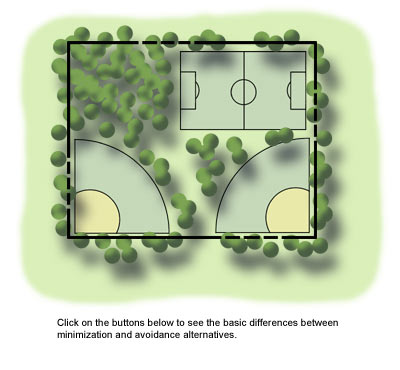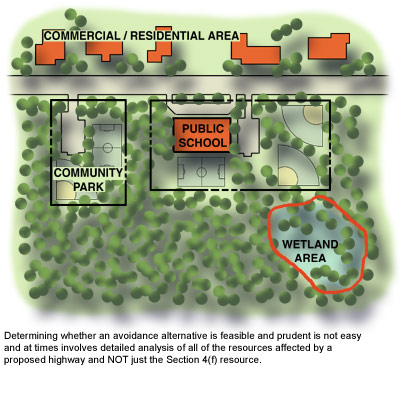Avoidance & Minimization
AVOIDANCE
Avoidance alternatives are those that entirely avoid the use of Section 4(f) properties. A key requirement of Section 4(f) compliance is an attempt to show whether or not a property can be completely avoided while meeting the transportation need. When the alternatives under consideration use land from one or more Section 4(f) properties, alternatives that avoid each of the properties must be evaluated.
 |
Alternate View |
Avoidance alternatives should consider minor alignment shifts, reduced cross-sections, retaining structures, modifications to the project and so forth. Avoidance alternatives that are eliminated from detailed study should be discussed in the Section 4(f) Evaluation with a clear explanation of why they are not feasible and prudent.
Note: Care should be taken to demonstrate consistent application of design standards throughout the project. For example, it would make no sense to propose the use of a reduced median width and narrower shoulders to minimize impacts to a wetland, while failing to apply the same logic to protect a Section 4(f) municipal park.
FEASIBLE & PRUDENT
When selecting an alternative the most important point to remember is if an avoidance alternative is determined to be feasible and prudent, it must be selected.
A feasible and prudent avoidance alternative avoids using Section 4(f) property and does not cause other severe problems of a magnitude that substantially outweighs the importance of protecting the Section 4(f) property. In assessing the importance of protecting the Section 4(f) property, it is appropriate to consider the relative value of the resource to the preservation purpose of the statute.
The regulations 23 CFR 774.17 set out factors to consider in determining whether an avoidance alternative is feasible and prudent:
- An alternative is not feasible if it cannot be built as a matter of sound engineering judgment.
- An alternative is not prudent if:
- It compromises the project to a degree that it is unreasonable to proceed with the project in light of its stated purposed and need;
- It results in unacceptable safety or operational problems;
- After reasonable mitigation, it still causes:
- Severe social, economic, or environmental impacts;
- Severe disruption to established communities;
- Severe disproportionate impacts to minority or low income populations; or
- Severe impacts to environmental resources protected under other Federal statutes;
- It results in additional construction, maintenance, or operational cost of an extraordinary magnitude;
- It causes other unique problems* or unusual factors; or
- It involves multiple factors listed above, that while individually minor, cumulatively cause unique problems* or impacts of extraordinary magnitude.
*Examples of unique problems include unacceptable social, economic or environmental impacts; serious community disruption; unacceptable safety or geometric problems; or excessive construction costs. An accumulation of these problems (as opposed to a single factor) may be a sufficient reason to use a Section 4(f) resource, but only if the problems are truly unique. Excessive cost alone will not necessarily prevent an alternative from being considered prudent.
 |
Alternate View |
A determination of an alternative's feasibility and prudence must take into account not only the impacts to Section 4(f) properties, but also the impacts to non-Section 4(f) properties, as well as the importance of the need for the project itself.
Furthermore, the impacts to Section 4(f) and non-Section 4(f) properties associated with one alternative must be compared to the impacts associated with other alternatives. This process is critical for determining whether an avoidance alternative is feasible and prudent. For example, an avoidance alternative resulting in the displacement of 50 homes may not initially appear to be feasible and prudent unless a comparison reveals that other alternatives that use Section 4(f) properties result in similar number of residential displacements, in which case the community disruption would be relatively equal among the alternatives considered. Other factors, however, such as the demographic nature of impacted neighborhoods, historic status, or even density of development may influence a different conclusion. For instance, an avoidance alternative that requires a smaller number of displacements, but a greater percentage of homes from a minority community, may not be considered feasible and prudent when compared with an alternative that uses Section 4(f) property but requires fewer overall displacements from non-minority communities.
